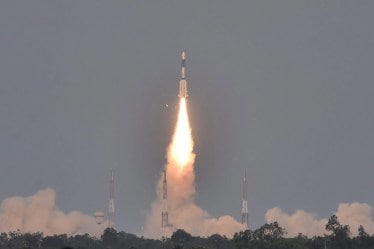India successfully puts its latest communication satellite GSAT-6A into orbit on Thursday. Indian Space Research Organisation’s (ISRO) GSLV rocket blasted off from the spaceport in Sriharikota, Andhra Pradesh yesterday and carried country’s communications satellite GSAT-6A along with it. Leaving behind plumes of smoke, the 49.1 metre tall GSLV soared majestically into clear skies yesterday – carrying the 2,140 kg GSAT-6A satellite at a height of about 36,000 km and injected it into a geostationary orbit.
This comes as a fifth consecutive success in the use of an indigenous cryogenic engine to fire an improved version of its heavy-lift GSLV Mk II rocket to launch a satellite into space, reported The Indian Express. More importantly, ISRO took a big step towards realising its second Moon mission. Scripting yet another success story in India’s space history, let’s take a look at how this new GSLV launch boosted India’s second mission to Moon.
• ISRO successfully placed its latest communication satellite GSAT-6A into orbit, launched onboard its geosynchronous rocket GSLV-F08 from the spaceport in Andhra Pradesh.
• This was the 12th satellite that was launched on board the GSLV rocket, coming as the fifth consecutive success for a GSLV which is equipped with an indigenously developed Cryogenic Upper Stage engine.
• The GSLV — specifically the GSLV F10 — is the designated rocket to fly India’s second mission to the Moon at the end of the year – The Chandrayaan 2.
• Chandrayaan-2, India’s second mission to the Moon is a totally indigenous mission comprising of an Orbiter, Lander and Rover, as per ISRo’s website.
• The Chandrayaan-2 weighing around 3290 kg and would orbit around the moon and perform the objectives of remote sensing the moon.
• The indigenous cryogenic stage on the GSLV is the third stage that uses liquid hydrogen as fuel and liquid oxygen as oxidiser.
• India had first ventured on the path of obtaining cryogenic technology in 1992, when it had purchased cryogenic engines from Russia, and acquiring the technology from the US.
• However, after 1998’s nuclear tests, US denied cryogenic technology to India following the sanctions that came up.
• ISRO used seven cryogenic engines sold by Russia for the early phase of its GSLV programme, while parallelly developed an indigenous technology.
• While in the absence of heavy-lift rocket technology, India has been relying on France for launching its communication satellites.
• Now, India is among six nations, along with the US, Russia, France, Japan and China, to possess cryogenic engine technology, a key frontier in rocket science.
Meanwhile, the Thursday launch has been considered as a very significant milestone in GSLV programme, as the new technologies would lead to enhancement of payload to more than 2.5 tonnes in near future. It was ISRO’s chairman K Sivan’s first assignment as the chief of the space agency – who assumed charge in January this year. He said the mission had happened to be an “important” one for him and added by saying that ISRO has lined up a host of “very high profile missions,” including Chandrayaan-2 and demonstration of human space programme this year.
